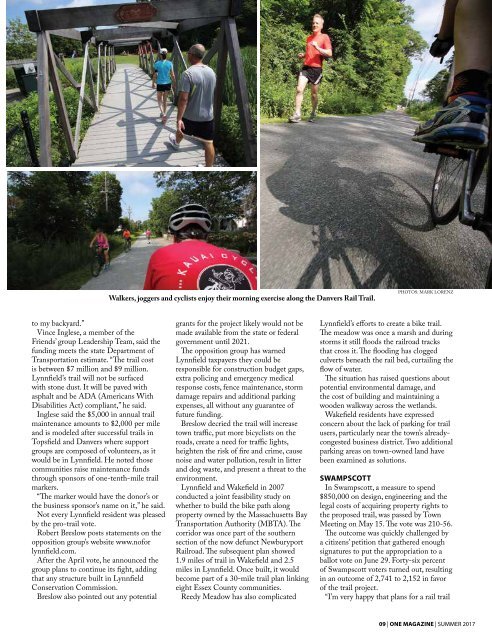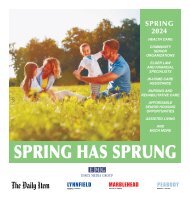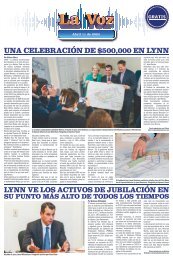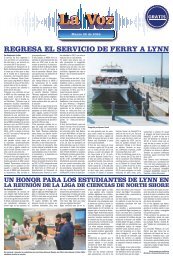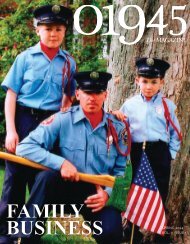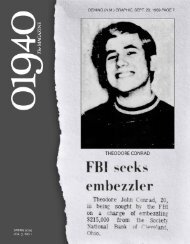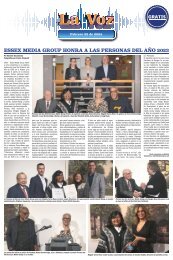ONE2017finaledits 08-03-17
Create successful ePaper yourself
Turn your PDF publications into a flip-book with our unique Google optimized e-Paper software.
Walkers, joggers and cyclists enjoy their morning exercise along the Danvers Rail Trail.<br />
PHOTOS: MARK LORENZ<br />
to my backyard.”<br />
Vince Inglese, a member of the<br />
Friends’ group Leadership Team, said the<br />
funding meets the state Department of<br />
Transportation estimate. “The trail cost<br />
is between $7 million and $9 million.<br />
Lynnfield’s trail will not be surfaced<br />
with stone dust. It will be paved with<br />
asphalt and be ADA (Americans With<br />
Disabilities Act) compliant,” he said.<br />
Inglese said the $5,000 in annual trail<br />
maintenance amounts to $2,000 per mile<br />
and is modeled after successful trails in<br />
Topsfield and Danvers where support<br />
groups are composed of volunteers, as it<br />
would be in Lynnfield. He noted those<br />
communities raise maintenance funds<br />
through sponsors of one-tenth-mile trail<br />
markers.<br />
“The marker would have the donor’s or<br />
the business sponsor’s name on it,” he said.<br />
Not every Lynnfield resident was pleased<br />
by the pro-trail vote.<br />
Robert Breslow posts statements on the<br />
opposition group’s website www.nofor<br />
lynnfield.com.<br />
After the April vote, he announced the<br />
group plans to continue its fight, adding<br />
that any structure built in Lynnfield<br />
Conservation Commission.<br />
Breslow also pointed out any potential<br />
grants for the project likely would not be<br />
made available from the state or federal<br />
government until 2021.<br />
The opposition group has warned<br />
Lynnfield taxpayers they could be<br />
responsible for construction budget gaps,<br />
extra policing and emergency medical<br />
response costs, fence maintenance, storm<br />
damage repairs and additional parking<br />
expenses, all without any guarantee of<br />
future funding.<br />
Breslow decried the trail will increase<br />
town traffic, put more bicyclists on the<br />
roads, create a need for traffic lights,<br />
heighten the risk of fire and crime, cause<br />
noise and water pollution, result in litter<br />
and dog waste, and present a threat to the<br />
environment.<br />
Lynnfield and Wakefield in 2007<br />
conducted a joint feasibility study on<br />
whether to build the bike path along<br />
property owned by the Massachusetts Bay<br />
Transportation Authority (MBTA). The<br />
corridor was once part of the southern<br />
section of the now defunct Newburyport<br />
Railroad. The subsequent plan showed<br />
1.9 miles of trail in Wakefield and 2.5<br />
miles in Lynnfield. Once built, it would<br />
become part of a 30-mile trail plan linking<br />
eight Essex County communities.<br />
Reedy Meadow has also complicated<br />
Lynnfield’s efforts to create a bike trail.<br />
The meadow was once a marsh and during<br />
storms it still floods the railroad tracks<br />
that cross it. The flooding has clogged<br />
culverts beneath the rail bed, curtailing the<br />
flow of water.<br />
The situation has raised questions about<br />
potential environmental damage, and<br />
the cost of building and maintaining a<br />
wooden walkway across the wetlands.<br />
Wakefield residents have expressed<br />
concern about the lack of parking for trail<br />
users, particularly near the town’s alreadycongested<br />
business district. Two additional<br />
parking areas on town-owned land have<br />
been examined as solutions.<br />
SWAMPSCOTT<br />
In Swampscott, a measure to spend<br />
$850,000 on design, engineering and the<br />
legal costs of acquiring property rights to<br />
the proposed trail, was passed by Town<br />
Meeting on May 15. The vote was 210-56.<br />
The outcome was quickly challenged by<br />
a citizens’ petition that gathered enough<br />
signatures to put the appropriation to a<br />
ballot vote on June 29. Forty-six percent<br />
of Swampscott voters turned out, resulting<br />
in an outcome of 2,741 to 2,152 in favor<br />
of the trail project.<br />
“I’m very happy that plans for a rail trail<br />
09 | ONE MAGAZINE | SUMMER 20<strong>17</strong>


